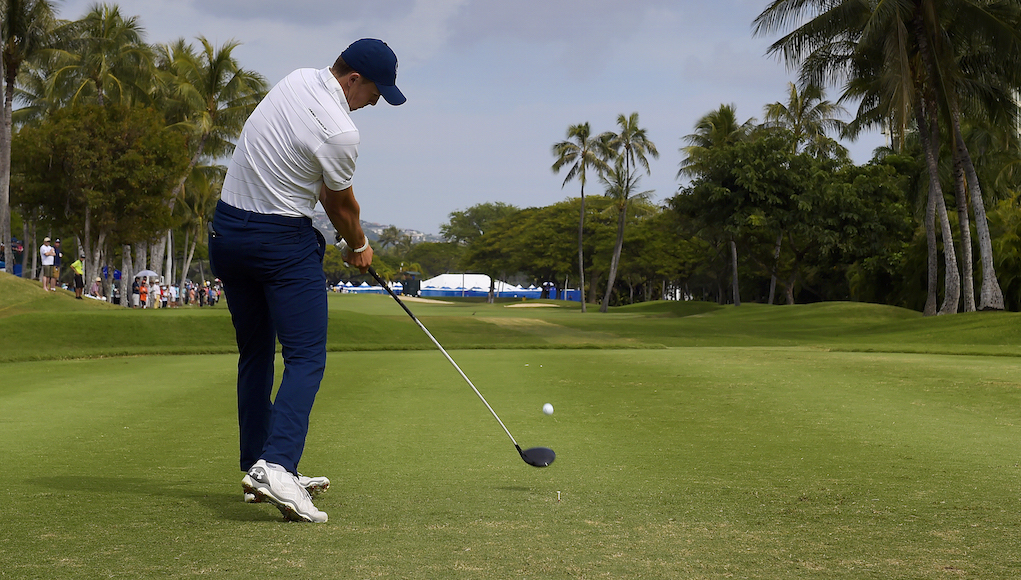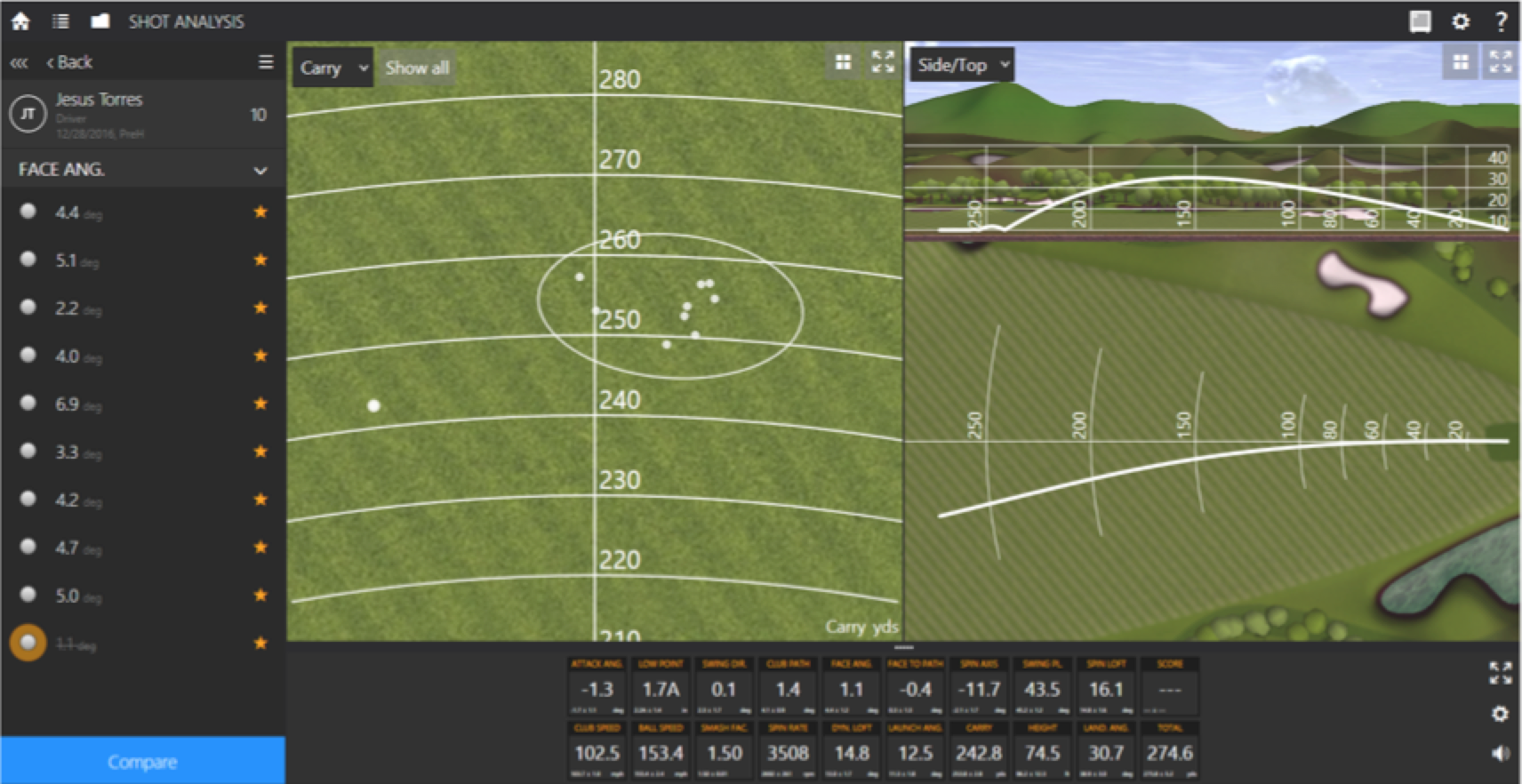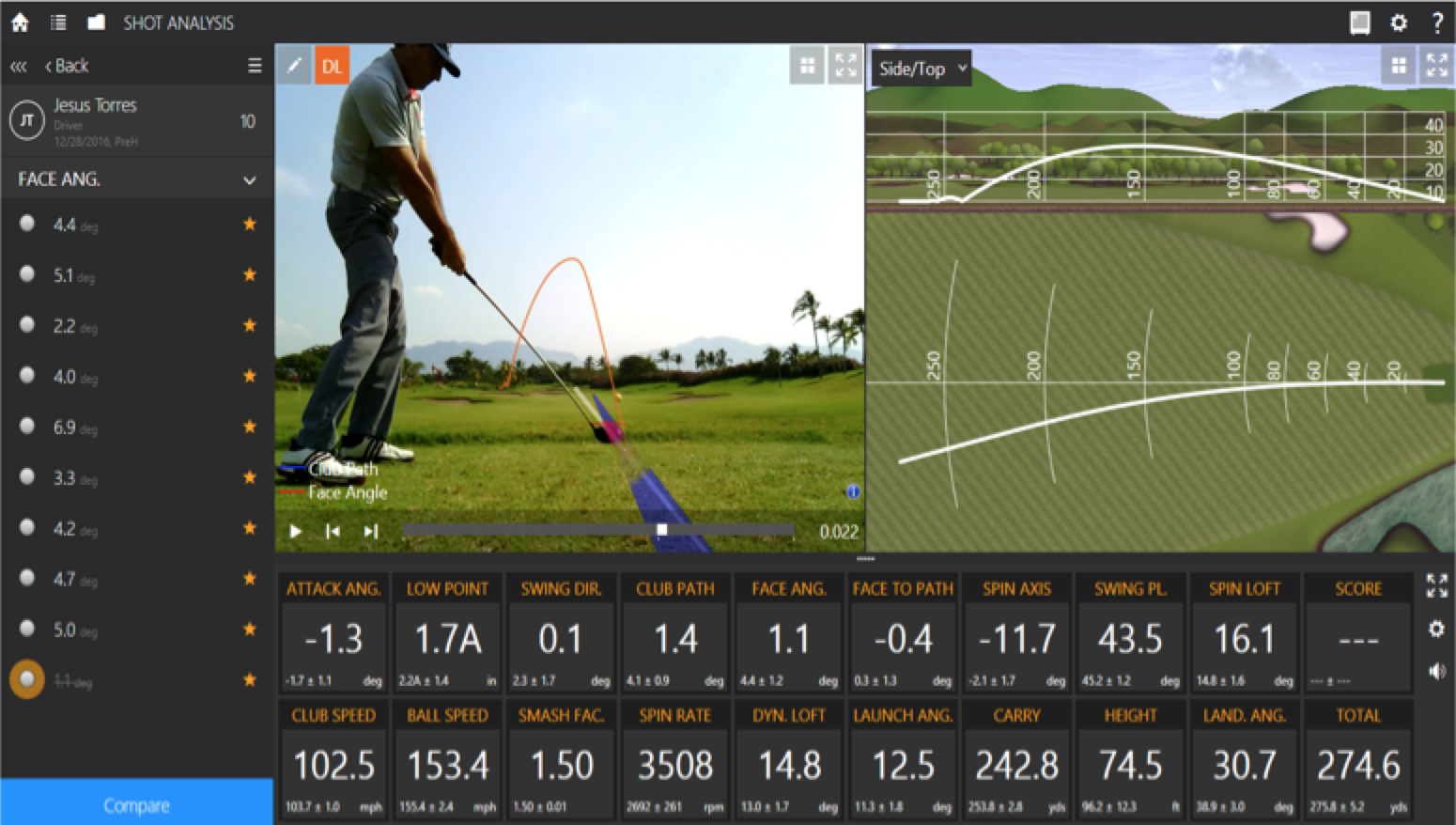Instruction
Is your swing broken, or are you just missing the sweet spot?

For the majority among us who often struggle to hit fairways, watching a good driver of the golf ball can seem like a magician pulling your card. How does he do that?!
“If only I could drive it like that, the game would be so much easier,” you think to yourself. And you know what, you’re right. Driving the ball consistently long and straight does make the game easier. Just like the rest of the game, however, it’s a skill you need to learn. And a good place to start is figuring out exactly why you’re hitting drives offline.
Big hooks and big slices can either be caused by a problem with your swing (an inconsistent face-to-path ratio) or something as simple as missing the sweet spot of your driver. Your job is to figure out which one is the culprit before you take any drastic measures such as changing your swing or equipment. If it turns out that you have a repeatable swing, then your wild hooks and slices are likely due to something called “gear effect.”
Related: Learn more about gear effect
Basically, here’s how gear effect works. I’m using right-handed golfer terms, so if you’re a lefty just reverse them.
- Toe hits usually make the ball move to the left or reduce the amount a golf ball will move from left to right.
- Heel hits make the ball move to the right or reduce the amount a golf ball will move from right to left.
Let’s look at one of the best drivers of the golf ball I teach here at the Vidanta Resort in Mexico. Jesus Torres played professionally for 10 years all over the world and hardly misses a fairway, so I figured I’d use him for this sample test.

Above is a chart of 10 drives he hit. If you look at the Trackman screen shot, you’ll notice he hit one shot way left. It was his first shot, and the rest of his drives were basically center cut. I told you, he’s a very good driver of the ball.
Below is a list of the face-to-path ratios for his swings, which are highly consistent. His variance only moves from 2.6 degrees to -1.9 degrees, which is very tight.
- -0.4
- 1.2
- 0.4
- 0.1
- -1.9
- 2.6
- -1.2
- -0.2
- 0.4
- 1.5
His average face-to-path ratio is 0.2 degrees, which shows that his “normal swing” has a face-to-path average that won’t cause the ball to curve offline too radically… that is, unless he hits the ball off-center. Now let’s examine the swing that caused his huge left miss.

Looking at the Trackman screen shot above, you can clearly see that Jesus hit the ball off the toe of his driver. With a slightly negative face-to-path ratio (-0.4 degrees) this ball should have moved gently left. The ball had a -11.7 degree spin axis, however, and you can see it moved way left. How? Gear effect from the toe hit, NOT his face-to-path ratio.
This example shows that Jesus should focus first on hitting the ball in the center of his club face before going out to the range and “working on his swing.” His swing is fine as you can see from his 10 drives; it was just a funky toe hit that caused the big miss.
Many golfers who struggle off the tee may face a bigger problem, but the only way to know for sure is to get on a Trackman or another launch monitor that measures face-to-path ratio and see how drastic your swing variance is. If it’s a fairly tight tolerance, then get yourself some foot spray and see where you’re hitting the ball on your club face.
Remember, let’s not worry about “fixing your swing” until we determine that your swing is actually the problem.
- LIKE115
- LEGIT12
- WOW1
- LOL3
- IDHT0
- FLOP1
- OB3
- SHANK23
Instruction
Clement: Laid-off or perfect fade? Across-the-line or perfect draw?

Some call the image on the left laid off, but if you are hitting a fade, this could be a perfect backswing for it! Same for across the line for a draw! Stop racking your brain with perceived mistakes and simply match backswing to shot shape!
- LIKE0
- LEGIT0
- WOW0
- LOL0
- IDHT0
- FLOP0
- OB0
- SHANK0
Instruction
The Wedge Guy: The easiest-to-learn golf basic

My golf learning began with this simple fact – if you don’t have a fundamentally sound hold on the golf club, it is practically impossible for your body to execute a fundamentally sound golf swing. I’m still a big believer that the golf swing is much easier to execute if you begin with the proper hold on the club.
As you might imagine, I come into contact with hundreds of golfers of all skill levels. And it is very rare to see a good player with a bad hold on the golf club. There are some exceptions, for sure, but they are very few and very far between, and they typically have beat so many balls with their poor grip that they’ve found a way to work around it.
The reality of biophysics is that the body moves only in certain ways – and the particulars of the way you hold the golf club can totally prevent a sound swing motion that allows the club to release properly through the impact zone. The wonderful thing is that anyone can learn how to put a fundamentally sound hold on the golf club, and you can practice it anywhere your hands are not otherwise engaged, like watching TV or just sitting and relaxing.
Whether you prefer an overlap, interlock or full-finger (not baseball!) grip on the club, the same fundamentals apply. Here are the major grip faults I see most often, in the order of the frequency:
Mis-aligned hands
By this I mean that the palms of the two hands are not parallel to each other. Too many golfers have a weak left hand and strong right, or vice versa. The easiest way to learn how to hold the club with your palms aligned properly is to grip a plain wooden ruler or yardstick. It forces the hands to align properly and shows you how that feels. If you grip and re-grip a yardstick several times, then grip a club, you’ll see that the learning curve is almost immediate.
The position of the grip in the upper/left hand
I also observe many golfers who have the butt of the grip too far into the heel pad of the upper hand (the left hand for right-handed players). It’s amazing how much easier it is to release the club through the ball if even 1/4-1/2″ of the butt is beyond the left heel pad. Try this yourself to see what I mean. Swing the club freely with just your left hand and notice the difference in its release from when you hold it at the end of the grip, versus gripping down even a half inch.
To help you really understand how this works, go to the range and hit shots with your five-iron gripped down a full inch to make the club the same length as your seven-iron. You will probably see an amazing shot shape difference, and likely not see as much distance loss as you would expect.
Too much lower (right) hand on the club
It seems like almost all golfers of 8-10 handicap or higher have the club too far into the palm of the lower hand, because that feels “good” if you are trying to control the path of the clubhead to the ball. But the golf swing is not an effort to hit at the ball – it is a swing of the club. The proper hold on the club has the grip underneath the pad at the base of the fingers. This will likely feel “weak” to you — like you cannot control the club like that. EXACTLY. You should not be trying to control the club with your lower/master hand.
Gripping too tightly
Nearly all golfers hold the club too tightly, which tenses up the forearms and prevents a proper release of the club through impact. In order for the club to move back and through properly, you must feel that the club is controlled by the last three fingers of the upper hand, and the middle two fingers of the lower hand. If you engage your thumbs and forefingers in “holding” the club, the result will almost always be a grip that is too tight. Try this for yourself. Hold the club in your upper hand only, and squeeze firmly with just the last three fingers, with the forefinger and thumb off the club entirely. You have good control, but your forearms are not tense. Then begin to squeeze down with your thumb and forefinger and observe the tensing of the entire forearm. This is the way we are made, so the key to preventing tenseness in the arms is to hold the club very lightly with the “pinchers” — the thumbs and forefingers.
So, those are what I believe are the four fundamentals of a good grip. Anyone can learn them in their home or office very quickly. There is no easier way to improve your ball striking consistency and add distance than giving more attention to the way you hold the golf club.
More from the Wedge Guy
- The Wedge Guy: Golf mastery begins with your wedge game
- The Wedge Guy: Why golf is 20 times harder than brain surgery
- The Wedge Guy: Musings on the golf ball rollback
- LIKE86
- LEGIT13
- WOW6
- LOL1
- IDHT0
- FLOP4
- OB1
- SHANK8
Instruction
Clement: Stop ripping off your swing with this drill!

Not the dreaded headcover under the armpit drill! As if your body is defective and can’t function by itself! Have you seen how incredible the human machine is with all the incredible feats of agility all kinds of athletes are accomplishing? You think your body is so defective (the good Lord is laughing his head off at you) that it needs a headcover tucked under the armpit so you can swing like T-Rex?
- LIKE0
- LEGIT2
- WOW2
- LOL0
- IDHT0
- FLOP0
- OB0
- SHANK2
-

 19th Hole2 weeks ago
19th Hole2 weeks agoDave Portnoy places monstrous outright bet for the 2024 Masters
-

 19th Hole3 days ago
19th Hole3 days agoJustin Thomas on the equipment choice of Scottie Scheffler that he thinks is ‘weird’
-

 19th Hole2 weeks ago
19th Hole2 weeks agoTiger Woods arrives at 2024 Masters equipped with a putter that may surprise you
-

 19th Hole2 days ago
19th Hole2 days ago‘Absolutely crazy’ – Major champ lays into Patrick Cantlay over his decision on final hole of RBC Heritage
-

 19th Hole3 weeks ago
19th Hole3 weeks agoReport: Tiger Woods has ‘eliminated sex’ in preparation for the 2024 Masters
-

 19th Hole1 week ago
19th Hole1 week agoTwo star names reportedly blanked Jon Rahm all week at the Masters
-

 19th Hole1 week ago
19th Hole1 week agoReport: LIV Golf identifies latest star name they hope to sign to breakaway tour
-

 19th Hole1 week ago
19th Hole1 week agoNeal Shipley presser ends in awkward fashion after reporter claims Tiger handed him note on 8th fairway















golfomatic
Feb 26, 2017 at 3:37 pm
The great thing about using foot spray at the range is that you can begin to guess pretty accurately where on the face you contacted the ball and associate that with both a feel and a ball flight. After awhile, you don’t need the spray any more to know how you’re contacting it. Thanks, Tom, for the tip about the RiteAid spray – I swear by it; I had another brand in the closet that didn’t work.
Skip
Feb 24, 2017 at 4:34 pm
With TrackMan, it’s just a guess that gear effect caused the hook. GC2 with HMT or the new GC Quad, it’s actually measured where on the face contact was made.
S Hitter
Feb 24, 2017 at 5:43 pm
Exactly.
Jerry C
Feb 24, 2017 at 12:15 pm
Here’s the question. If you can’t find the center of the clubface does that not point out a swing flaw? I agree you need to hit the center before you go fixing something that’s not broken, like path. Tip: Get your foot spray at the $0.99 store. Works just as good as the Dr. Scholl’s for this at 20% of the cost.
TR1PTIK
Feb 24, 2017 at 12:51 pm
My experience has shown me that if you play and practice frequently enough, that you probably have a repeatable swing. Whether the swing is good, bad, or somewhere in between is anyone’s guess, but chances are with a repeatable swing and a consistent setup you can strike the same spot on the club (or close to it) every swing. If you can then make the necessary adjustments (often in the setup) to find the center of the clubface, you can examine ball flight to tell you what your swing is doing. This is essentially the point of the article as I interpret it.
Ball flight from a centered strike will tell you more about what your swing is doing than anything else if you don’t have a launch monitor available.
Scott
Feb 24, 2017 at 9:44 am
What are some good drills to practice hitting the middle of the club face more consistently?
Eddie
Feb 24, 2017 at 12:23 pm
Impact tape or athletes foot spray and a large bucket of balls. Slow your swing down until you find the center consistently and slowly work your way back up to full speed.
david
Feb 24, 2017 at 9:44 am
why don’t you first check your grip and alignment?
TR1PTIK
Feb 24, 2017 at 9:18 am
Good article. I struggled to believe I had a very consistent swing for a long time and would always hit the range to try and fix things that were never a problem. Even after having some lessons with a FlightScope handy I still didn’t really grasp what was happening. It wasn’t until last month when I did a full bag analysis on Trackman that I learned just how consistent and repeatable my swing actually is. Now, I pretty much just focus on ball striking using foot powder spray to detect impact location.
Don M
Feb 24, 2017 at 9:14 am
It’s funny to me that club designers seem to be making clubs that don’t have the proper amount of bulge. In theory, if the bulge is proper, Jesus’s toe hit would have started more to the right, and come back to center. In the 460cc era, this type of correction seems to be lost, so we get hooks from toe hits.